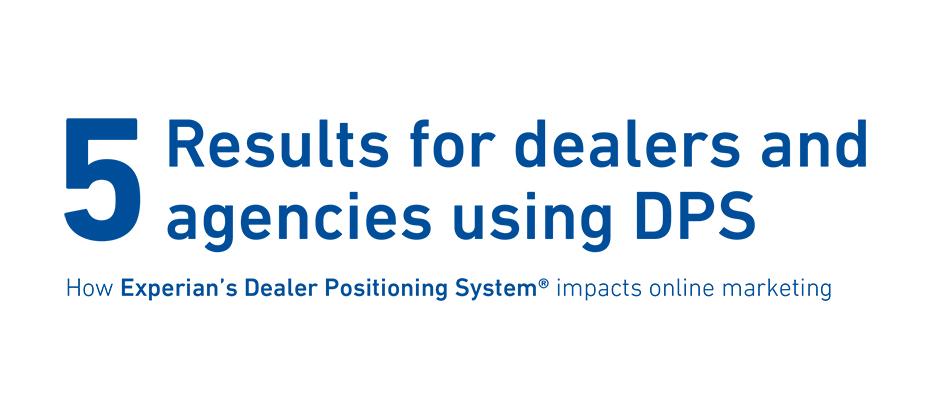Tag: DPS

The auto industry is blessed with an abundance of data - market research, demand estimates, demographic trends, registration history, not to mention your dealership's own sales and inventory data. Dealers are often visual people - who love beautiful cars more than boring spreadsheets. The more visual you can make your data, the easier it will be to make decisions based on what it's telling you. Here are the five steps to being a data-driven dealer. 1. Where am I selling the most cars? You probably have a good instinct about where the "hot spots" are around your dealership. But there's a reason many dealers often display a map somewhere in the dealership, with pushpins representing recent new and used sales. It's a tried-and-true technique because there's no substitute for a visual representation of data, especially to get a good sense of where you're currently successful. More importantly, it will also help you answer a critical question - where should I be selling the most cars? By layering your web stats, such as Google Analytics, on top of your sales data, you can start to see whether your PPC spend is resulting in sales. Then layer on registration data to understand whether you're maximizing opportunity in your own backyard. You might already be selling a lot of cars into a town, but looking at your on-brand market share will help you determine if you've fully penetrated the area. Looking at overall market activity, not just your own data, is required to understand where you fit into the bigger picture and decide upon your best sales strategy. 2. Where should we be conquesting? Once you've confirmed that you're (hopefully) dominating in your town and those directly adjacent to you, it's time to turn your eye to how to take on competitive dealerships farther afield. Again, data can help you determine next steps and target your budget appropriately. Every dealership approaches and defines "conquesting" a little differently, but there are two common techniques that can be made much easier using recent registration statistics. First, look for ZIP Codes outside of your immediate PMA that are selling a high number of on-brand vehicles. These are your competitors' happiest hunting grounds; focus on enticing shoppers in those areas to drive a little further to take advantage of special pricing or promotions, rather than attacking blindly in a 20-mile radius. 3. What is my best performing campaign now? No matter what your position is at the dealership, you need to know what's working best at any given moment. The GM needs to be able to make on-the-fly budgeting decisions, while the e-commerce Director wants to know which campaigns are working and what to do more of. But too often, the only objective measures we're regularly provided are traffic stats. Traffic is important, of course, but we'd suggest there are three factors dealers should evaluate for every campaign. A campaign may be driving lots of shoppers to your site, but if they're immediately leaving the site, they aren't worth much for you. A high bounce rate is your first sign that something is amiss since shoppers aren’t finding what they were looking for on your site. A second-level analysis involves looking at what other pages visitors looked at after hitting the campaign landing page. For an offer focused on a specific vehicle, visitors should be moving on to look at inventory on VDP pages. Free oil change promotion? Visitors should be spending time on the service portion of your site. Work with your agency or internal e-commerce team to determine what content, language and images are the most effective at engaging potential buyers to take the desired action. Speaking of action, conversion rate is your single best measure of whether a campaign is performing to expectations. Just make sure you're measuring actions that matter: Form submissions, email leads, mobile clicks to call, and visits to hours and directions pages all indicate various levels of positive customer interest in beginning a dialogue. 4. How do I determine whether my traditional advertising spend is producing results? Measuring dealer marketing ROI can be challenging, especially for traditional advertising. History tells us that radio, TV, newspaper, and outdoor are successful in driving demand, but quantifying that effect can be an elusive goal. But there are methods that will get you closer to determine the effect of your traditional efforts on sales. By tagging the start dates of all your marketing activities and mapping them on a trendline of your traffic for your URLs, leads such as phone calls, chat, and coupon codes for your service department as well as sales, you'll get a good sense about whether your offline campaigns are generating online interest. 5. Who is my ideal customer? Once you understand which models are likely to move next month, your next question should be: "Who am I selling to?" You probably have a good sense of your typical customer profile for many models (there's a good chance you're showing minivans and SUVs to young families, for example). But do you know where those customers live? And how to best talk to them? There is an incredible amount of data available on consumers, from credit history to buying behavior to lifestyle preferences. So how do you make use of this rich consumer data? At a basic level, Experian data can tell you a lot about the residents of each ZIP Code surrounding your dealership - from average age, income, and number of children, all the way to the most prevalent Mosaic® profiles in each town. In a previous article, we talk about locating your ideal customer using Mosaic profiles. You might have a high number of "American Royalty" in one area, or an abundance of "Sports Utility Families" just a couple of towns over. This information can tell you not only where you might want to market particular models, but what medium and messaging will resonate best in each area. While only 15 miles apart, the Boston suburbs of Sudbury and Norwood are home to very different types of BMW buyers, suggesting vastly different marketing campaigns to best appeal to each. Data is a necessary tool for understanding your ideal customer, improving your marketing results, and selling more vehicles. These five steps to becoming a data-driven dealer address all your requirements to enrich your marketing and conquest more successfully.

When sales are going relatively well, do you immediately look to conquesting? Are your key vendors encouraging you to do so? There’s absolutely nothing wrong with being out to conquer the world. No matter how you define conquesting – stealing market share from your competitors on their turf, making inroads on a cross-shopped make, or expanding your sales radius – chances are, you shouldn’t be focused on doing it. At least not until you’ve created some high barriers to prevent competitors from encroaching into your territory. Luckily, it’s easy to know when to stop conquesting and start getting defensive. All you need to answer is one simple question: Do you own your backyard? Even when it feels like all is going well in terms of sales and market penetration, it’s worth taking another look. You might be doing lots of volume in your immediate vicinity, but still be missing out on a lot of potential sales that are going to your competitors. We suggest that most dealers shouldn’t be happy with anything less than 90% market share of new, on-make models in surrounding ZIP Codes™. If you’re not regularly tracking your “backyard” market share, it’s a good practice to get in. Here’s why you should care about totally shutting out the competition in your local area: You’ve got physical brand presence. Buyers in your ZIP code and the surrounding towns drive by your sign every day. Your name should be the first they that comes to mind when they think of your make. You should own hometown SEO. Do you own search terms like “Honda dealers in Lakeland”? If you’re not the number one organic search result for your town, you’ve got some work to do. These are your most likely service customers. Every local deal you walk away from is a potential – and profitable – service customer lost. If you don’t own your backyard, what should you do about it? Aside from making sure you’ve got your SEO and SEM in good shape, it may well be an inventory problem: Are you stocking the models that buyers in your area are looking for? Here’s where looking at data from outside your four walls can be helpful. Demand data which aggregates online search activity to determine what models shoppers are likely to be buying in the next six weeks – can be a great resource to determine what’s going to be hot. This can certainly assist you in acquiring in-demand used inventory, and while you don’t always have control over your new allocations, a grasp of local purchase trends can help you figure out where and how to successfully market the models you do have on your lot. You may find that one or two problem models are dragging down your total market share – either because you have a large volume of them in stock and they aren’t moving, or they are hot sellers and you don’t have enough of them to meet demand. Once you’ve got the basics covered and you’ve identified any inventory gaps, let’s get granular about your strategy to dominate market share. A great way to do that is to look at the models and zip codes where you’re losing market share, starting with your bread and butter models. Dig in and look at your market share, by ZIP code, for each of your high-volume models. If you’re well under that 90% threshold on Focuses or 3-series, for example, that’s a good place to start targeting your marketing efforts in your backyard. So how do you sell more cars into the Zip codes you’ve identified? By understanding the prospective buyers of your chosen model and laser-targeting your marketing to appeal to them. Demographic data from the likes of Experian Automotive can provide a rich array of details on the values and preferences of buyers who are most likely to be interested in your specific vehicles. From the advertising channels that reach them, to the types of offers and benefits they prefer to hear about, there’s a plethora of valuable information available to inform successful campaigns. Armed with this data, it’s possible to hone your messaging to appeal to those individual buyers, especially when undertaking campaigns that can be targeted down to the ZIP code level, such as PPC and direct mail. If you’re not already buying your PPC by ZIP code, and creating model-specific landing pages with customized messaging for each area, we highly recommend it for a dramatic effect on conversion. We’ve seen rates rise from 2% to 8%, and inventory engagement rates rise from 50 to 90%, just by employing these techniques. By employing your marketing dollars more strategically and creating messaging that better resonates with consumers, you’ll be well on your way to consistently achieving dominant market share in your own backyard. But once accomplished, the work is not done! Be sure to experiment with conquesting against competitive makes – and do so in a controlled and measurable way. Here are some considerations as you set your strategy: Choose just one make to take on… but avoid conventional wisdom. If you’re a Honda dealer, conventional wisdom says conquest Toyota – since they consistently show up in the list of cross-shopped makes for Honda, regardless of market. But Toyota buyers are highly loyal… how much are you going to have to spend to convince them to leave their tried and true models? Why not go after Kia or Hyundai instead? Stick with your bread and butter models. You might be all excited about that shipment of new electric vehicles you just got in stock, but those “specialty” buyers are going to seek you out. For the highest impact, spend your conquesting dollars where you’re doing the most volume. For example, , if you’re a BMW dealer, put your 3-series up against the Lexus IS. Choose 3-4 ZIP codes in your PMA where demand is highest. It may be tempting to try to lure buyers who are farther afield, but you are more likely to lose on the front and back end of every sale that’s over 20 miles from your dealership. Remember, we’re looking for buyers that are easy to lure and have a good shot at becoming loyal service customers These techniques can be used persistently to ensure that you own your backyard, dominate your PMA and steal market share from your competitors. All it takes is knowledge of your market. Your gut will lead you in the right direction most of the time, but look at the data to verify your instinct, and be open to being surprised. Take the time to wait for results before moving on to the next campaign. You’re guaranteed to learn something that will make you better next time. And there’s no need to go it alone. All this data and the accompanying visualizations can be found in Experian’s Dealer Positioning System®, or DPS, a dealership intelligence platform created expressly for auto retail. The DPS can surface recommendations on the models and ZIP Codes with the most opportunity, and a monthly Market Guidance call with one of our Performance Managers who can help you crystallize your strategy, track results, and hold you and your extended team accountable. Experian also has a growing list of agency partners who use the DPS to help clients like you shape and execute on effective marketing and advertising campaigns.

When dealerships market a particular make or model, they may only think of targeting by geography. In a previous article, we talked about hitting the mark for effectively geo-targeting down to the ZIP Code™ level. The trouble is this is only one half of the puzzle. You may know where you should target but might not know whom to target. What is the best way to create campaigns tailored to the individuals within the specific area you are targeting? If you already use Experian’s Dealer Positioning System (DPS), you have a leg up on this. Since we already talked about targeting by ZIP Codes, the next step finding out household attributions and profiles in those areas. The above example is a ZIP Code in Sun City West, Arizona. We see three different lifestyle segments sourced from Experian’s Mosaic®, a system that classifies households into 71 unique types and provides information about consumer’s choices, habits, and preferences. Within the 1,702 households in this Zip Code that registered a vehicle within a defined timeframe, we can determine the three primary types of household segments. As we can see, Footloose and Family Free dominates this area at 66%. This group consists of elderly couples and widowed individuals living active and comfortable lifestyles. Gold Carts and Gourmets, upscale retirees and empty-nesters in comfortable communities comes in at 20%. The remainder is Booming and Consuming, older empty-nesting couples and singles enjoying relaxed lives in small towns. This information gives us insight into the people living in various types of households within this particular ZIP Code and. These also show personal preferences for purchasing such as clothing, accessories, electronics, and so on, household marital status, and what types of vehicles they usually purchase. From this information, for Sun City West, Arizona, we can see that the average income in this ZIP Code is $67,000. After we look at the Mosaic profile of households, we can look at advertising propensity and channel dominance. These demonstrate how vehicles buyers in this ZIP Code were influenced in their purchase decision and shows what advertising influenced them the most. Traditional advertising such as newspaper, TV, or radio was more effective versus Direct Mail in this area with a ratio of 8:7. The difference between Email and Direct Mail for channel dominance is 1:1. That’s good because it means consumers here were equally responsive to both emails and direct mail. The left side of the table displays the type of households you can target, but the right side is all about how to best market to them. “Messaging Attributes” indicates the top key messaging that influenced the people in this ZIP Code’s buying decision. For this ZIP Code, Buy American is the top attribute. Consumers in this segment would like to know the history of your dealership, and details of your community involvement, and if your vehicles are made in America. If we go 9% lower, we see Look at me Now. This messaging focuses on customer relationships, dealership reputation, and gifts for going on test drives. Finally, there is On the Road Again. Here, focus is on customer testimonials, base trim levels of vehicles, and simple, value-focused messaging. As a dealer, you have three effective messaging attributes that you can use to bring consumers from this ZIP Code into your store. Effectively marketing your vehicle to consumers is easier once you know to whom you’re marketing. By using the Lifestyle Cluster and Mosaic lifestyle segmentation system, you can see not only who you are targeting but what kind of marketing they prefer. Along with idenitfying which ZIP Codes to target, figuring out what marketing attributes resonate with these consumers means you’ll provide the right message in the right place to the right consumer.

Throughout the year, there are certain models that are incredibly popular. SUVs and crossovers fly off the shelves during the wintertime while down south, the pickup-truck is the sales king. There are times when less popular vehicles flood your inventory, creating stress for your sales team to try and get them into the hands of customers. The good news for dealers is that you don’t need to panic when strange bonus programs are floated out by the manufacturer. Data-driven methods can be used to find potential buyers. The upshot of this is dealers don’t have to wait for buyers to waltz into their showroom. Although you can pick a specific model based on incentives, it is a good idea to review your model goals to confirm they are realistic. Based on the models you are trying to move, identify the sales trends by unit and geography. This analysis may help you discover the vehicle margin opportunity isn’t worth the advertising investment. On the other hand, you may learn competitors are selling a plethora of that model and there is plenty of room to conquest market share. Always let data be your guide. Checking a vehicle’s popularity can determine if you should market it. If the model’s popularity in your geography is growing, it will be easier since potential consumers are going into showrooms, asking questions, and doing research online. On the flip side, a vehicle with declining popularity is more difficult, and therefore more expensive, to market. As vehicles become unpopular or out-of-season, aggressive pricing may be in-store. In the past, the “spray and pray” method was what dealers and marketers would use, simply hoping that your campaign would find your target. Today, the best practice is to pinpoint the demand for your model by analyzing your pre-determined market radius to identify those ZIP Codes™ which show the most interest. For example, narrowing down to neighborhoods showing recent sales of your model can help identify future purchase demand. When combined with demographic, psychographic, web analytics, and your CRM data, the formula for determining model-specific demand becomes a precise science. Determining where to market is one thing, but identifying the in-market customer is another thing altogether. To identify the persona for potential purchasers of your models, utilize a system like Experian’s Dealer Positioning System. It helps determine the demographics and psychographics of consumers along with various buying patterns. This persona will include what interests consumers of your model and what they value in a marketing message. While creating the persona, think about what kind of marketing would be the most effective. Are your customers on social media and would they prefer digital advertising? Perhaps a more traditional approach with direct mail or by phone? Understanding their preferences will indicate which approach will most effectively resonate with them. Now campaigns for your model of choice can begin. Use the ZIP Codes and demographics of your highest potential customers to create an effective media plan. Based on the data, craft out digital, traditional, or other campaign types that can be run successfully. Focus on the features that will most appeal to your key demographic– all-wheel-drive, navigation, advanced safety features, made in America, etc. Moving that model off the lot and onto the customer’s driveway does not have to be difficult. If the model is not popular in the first place or it isn’t the right time to market it, you may not want to spend money trying to promote it. With the methods we stated earlier, selling a vehicle to customers based on geotargeting and specific marketing messages make moving even the most unwanted vehicle easier. Also, remember the where, who, and what. Where are you targeting your customers, who are your customers, and what medium are you going to use? Using this can help to move that model and grant you sales success.

Below is our 5 Results for Dealers and Agencies Using DPS infographic.